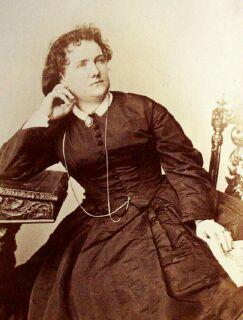 The blurb at the top of the Modern Library Classics edition of The Trail of the Serpent happily announces that the novel is back in print after nearly a century. For such a readable – nay, almost modern – novel, you wonder at what cultural forces kept this florid little gem hidden for so long.
The blurb at the top of the Modern Library Classics edition of The Trail of the Serpent happily announces that the novel is back in print after nearly a century. For such a readable – nay, almost modern – novel, you wonder at what cultural forces kept this florid little gem hidden for so long.Mary Elizabeth Braddon (1835-1915) is pretty much credited as writing the first detective novel, even before Wilkie Collins’ The Moonstone (frankly, I think Braddon’s novel far more entertaining). Financial pressures forced Miss Braddon to work as an actress to support her mother and sister. She went by the stage name of Mary Seyton. To avoid total scandal (actresses were thought of as little better than prostitutes in those days), Braddon safeguarded her reputation by having her mother go chaperone whilst on tour.
The wild and fantastic goings on that constitute the plot of The Trail of the Serpent are far too involved to go into here. As I read it, though, all I could think of was Oscar Wilde’s maxim: nothing succeeds like excess. Not only does Braddon have a penchant for overwriting, she also likes to go over the top. This is the sort of novel that Lady Bracknell would thoroughly disapprove of, but read nonetheless. I dare say Wilde, too, would think be critical of Braddon’s work on aesthetic grounds, but secretly read her work with great pleasure. How can I put this another way? The Trail of the Serpent has lots of high camp. (I wonder if Susan Sontag lists it in her famous Notes on Camp?)
For example, in the French section of the novel, when Valerie de Cevennes poisons her husband (whom she secretly married), Gaston de Lancy, the death scene is extraordinarily over the top. Gaston is an opera singer, and he is slipped the poison before he goes on stage. Naturally enough, mid performance, and before an audience, he collapses. Women are forever shuddering and passing out in this novel, while the men scheme and plot.
Braddon also seems keen to keep us on the cusp of immorality. When the wicked Jabez North is at last captured, dragged before a court and found guilty, the author cannot resist painting him as irresistibly attractive. The murderer was, we are told, ‘much admired in the Chamber of Horrors at the eminent wax work exhibition’.
Also, women find him sexually attractive:
‘Young ladies fell in love with him, and vowed that a being – they called him a being – with such dear blue glass eyes, with beautiful curly eyelashes, and specks of lovely vermilion in each corner, could never have committed a horrid murder.’
Mary Elizabeth Braddon also reminds me of Alfred Hitchcock, and I speculate that he would have been intimately familiar with her work. Remember that famous Hitchcock quote about what makes a good film? ‘Murder, mayhem, all beautifully lit, gorgeous costumes…’ This is what you get spades of in The Trail of the Serpent. Indeed, for some reason, the lush cinematography of Hitchcock’s Vertigo kept on playing through my mind as I read the wonderfully vivid descriptions of the French sections of the novel.
If you like highly wrought novels, bordering on the decadent, then you most likely will enjoy this long forgotten novel.
Great Blogg. Thanks for letting me visit. You might find this link helpful. If you do, could you please link to me. stopping comment spam and ads?
ReplyDelete